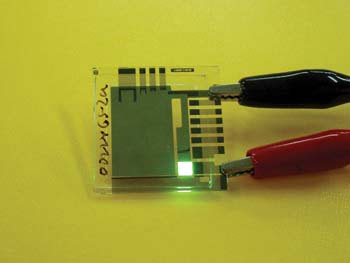
OLED Exhibits ~10 Percent External Quantum Efficiency
Daniel S. Burgess
Scientists at Sanyo Electric Co. Ltd.’s Advanced Energy Research Center in Hirakata, Japan, have obtained an external quantum efficiency of 9.9 percent from a green fluorescent organic LED (OLED). They note that the presumed maximum external quantum efficiency of the device was 5 percent, and suggest that the suitability of fluorescent OLEDs for a variety of display and illumination applications should be reconsidered.

The green fluorescent organic LED exhibits an external quantum efficiency of nearly 10 percent, higher than predicted. Courtesy of Hiroshi Kanno.
When a voltage is applied to an OLED, the injected electrons and holes combine to form higher-energy excitons with a spin of zero, called singlets, and lower-energy excitons with a spin of one, called triplets. The exact ratio of generated excitons remains a matter of debate, but spin statistics state that three-quarters will be triplets and that one-quarter will be singlets.
Because the dopants in phosphorescent OLEDs can harvest both triplets and singlets, those devices theoretically offer a maximum internal quantum efficiency of 100 percent and an accordingly high external quantum efficiency — a function of the external efficiency and the outcoupling efficiency. Unfortunately, their performance suffers at driving current densities greater than 1 mA/cm2 as a result of triplet-triplet annihilation, which may make them unsuitable for use in large-area displays and other high-brightness applications.
Fluorescent materials, in contrast, use only singlets, so the theoretical maximum internal and external quantum efficiencies of fluorescent OLEDs are much lower than those of their phosphorescent counterparts. Their internal efficiency does not fall with increasing current density, however, so they outperform phosphorescent devices at high driving currents, said Hiroshi Kanno, a chief researcher at Sanyo.
Kanno explained that the investigators selected materials for the green OLED that would inject roughly the same number of electrons and holes into the emitting layers to maximize exciton formation. Using vacuum thermal evaporation, they deposited three organic layers — a 60-nm-thick NPB hole-transport layer, a 40-nm-thick coumarin-doped TPBA emission layer and a 20-nm-thick DBzA electron-transport layer — atop an ITO-coated glass substrate that was covered with a plasma-generated fluorocarbon to improve hole injection. The device was completed with the deposition of a layer of LiF and an aluminum cathode.
The OLED displayed an output spectrum with a peak at 500 nm and a full width half maximum of 63 nm, and its external quantum efficiency of approximately 10 percent was stable across the range of current densities from 2 to 100 mA/cm2. The researchers collected current-voltage-luminance measurements using a digital electrometer from Keithley Instruments Inc. of Cleveland and a spectrophotometer from Otsuka Electronics Co. Ltd. of Hirakata. To determine the external quantum efficiency of the OLED, they employed a spectroradiometer from Topcon Corp. of Tokyo, which was connected to a 6-in.-diameter integrating sphere.
They compared the performance of the emitter with that of another fluorescent OLED that they constructed by the same process but using 60-nm-thick NPB and 60-nm-thick Alq organic layers. The control device exhibited an external quantum efficiency of approximately 1 percent, leading them to conclude that the higher efficiency of the three-layer OLED was the result of material selection (likely the use of the anthracene derivative DBzA) and not the result of enhanced outcoupling.
Under a constant 80-mA/cm2 DC driving current, the half-luminance lifetime of the OLED was 71 hours, from which they calculated a lifetime of 78,000 hours from an initial luminance of 300 cd/m2. Although they note that this is consistent with devices that other research groups have produced, Kanno said that more robust materials would be necessary for practical applications.
Applied Physics Letters, Aug. 7, 2006, 063504.
/Buyers_Guide/Sanyo_Electric_Trading_Co_Ltd/c13092